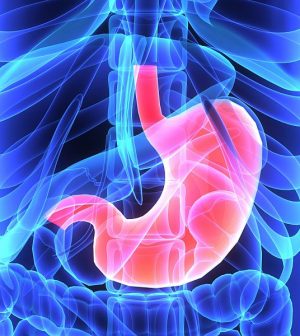- Navigating Your Midlife Crisis: Embracing New Possibilities
- City Raccoons Showing Signs of Domestication
- Mapping the Exposome: Science Broadens Focus to Environmental Disease Triggers
- One Week Less on Social Media Linked to Better Mental Health
- Your Brain Changes in Stages as You Age, Study Finds
- Some Suicide Victims Show No Typical Warning Signs, Study Finds
- ByHeart Formula Faces Lawsuits After Babies Sickened With Botulism
- Switch to Vegan Diet Could Cut Your Greenhouse Gas Emissions in Half
- Regular Bedtime Does Wonders for Blood Pressure
- Dining Alone Could Mean Worse Nutrition for Seniors
Pill Expands in Your Stomach to Spot and Track Disease

An expandable pill that can stay in the stomach for a month could help diagnose and monitor a myriad of gastro ills, a new study in pigs suggests.
The pill has a Jell-O-like consistency. Once it reaches the stomach, it quickly swells to the size of a ping-pong ball and is resistant to the stomach’s roiling acidic environment, according to the Massachusetts Institute of Technology (MIT) team.
If the pufferfish-inspired pill needs to be removed, a patient can drink a solution of calcium that causes the pill to quickly shrink to its original size and pass safely out of the body, the study authors explained in an MIT news release.
For the study, the researchers embedded small temperature sensors into several pills that were fed to pigs, which have stomachs and gastrointestinal tracts very similar to humans. After retrieving the sensors from the pigs’ stool, the investigators found that they accurately tracked the pigs’ daily activity patterns for up to 30 days. However, animal research does not always pan out in humans.
The pill is made from two types of hydrogels — mixtures of polymers and water — making it softer and longer-lasting than current ingestible sensors, which either are only able to remain in the stomach for few days, or are made from hard plastics or metals that are much stiffer than the gastrointestinal tract.
“The dream is to have a Jell-O-like smart pill, that once swallowed stays in the stomach and monitors the patient’s health for a long time, such as a month,” said researcher Xuanhe Zhao, an associate professor of mechanical engineering at MIT.
Study co-lead author Xinyue Liu explained that, “currently, when people try to design these highly swellable gels, they usually use diffusion, letting water gradually diffuse into the hydrogel network. But to swell to the size of a ping-pong ball takes hours, or even days. It’s longer than the emptying time of the stomach.”
The MIT team succeeded in creating a hydrogel pill that could inflate much more quickly. They said they were inspired by the pufferfish. When threatened, it inflates by quickly sucking in a large amount of water.
Eventually, it may be possible to use the pill with a number of different sensors to check pH levels or for signs of certain bacteria or viruses, or with tiny cameras to monitor tumors or ulcers for several weeks, the researchers said.
The pill might even offer a safer, more comfortable alternative to the gastric balloon, a form of weight control in which a balloon is inserted through a patient’s esophagus and into the stomach.
“With our design, you wouldn’t need to go through a painful process to implant a rigid balloon,” Zhao said. “Maybe you can take a few of these pills instead, to help fill out your stomach, and lose weight. We see many possibilities for this hydrogel device.”
The study was published Jan. 30 in the journal Nature Communications.
Here’s a short video, supplied by the researchers, of the pill expanding in water:
More information
The American College of Gastroenterology has more on the gastrointestinal tract.
Source: HealthDay
Copyright © 2025 HealthDay. All rights reserved.










